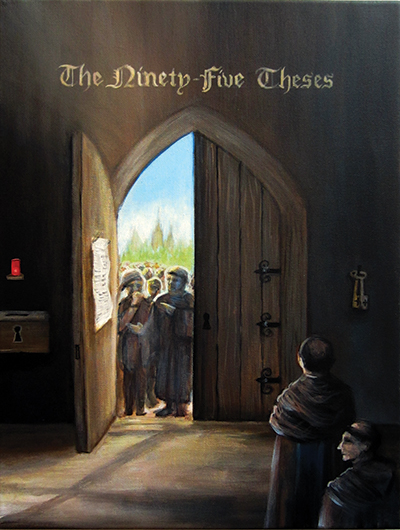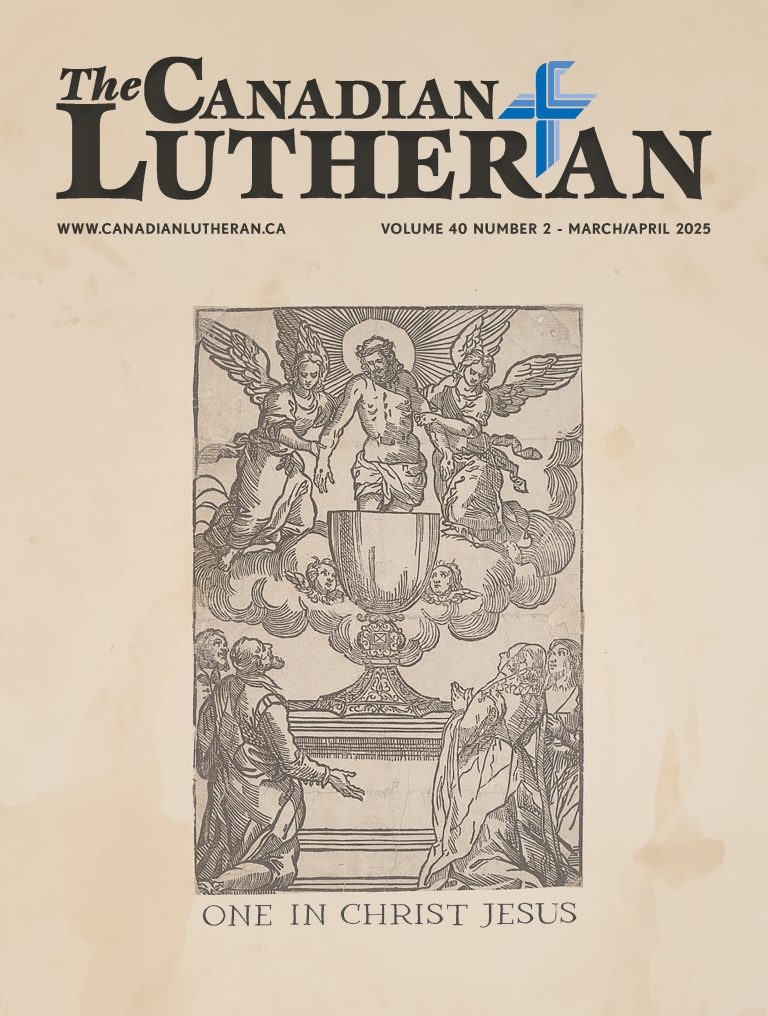Reformation 2017 Artwork: The Ninety-Five Theses
Editor’s Note: Kelly Klages has agreed to prepare six pieces of original art for Lutheran Church–Canada (LCC) commemorating the 500th anniversary of the Reformation in 2017. Each piece of art will be featured on the covers of this year’s issues of The Canadian Lutheran magazine.
In addition, each piece of art is being made available to LCC congregations as a free, downloadable poster. You can print out the posters, along with accompanying artist’s statement, as they become available at www.reformation2017.ca/resources/posters/.
by Kelly Klages
 The first painting in this series, “The Ninety-Five Theses,” represents the incident that has become most closely associated with the beginning of the Reformation in the eyes of the world. Alarmed at the unscriptural practices of the local indulgence sellers, and distraught at the enabling of greed and false piety, Luther proposed a debate on the issue. On October 31st, 1517, the theses were issued in an irenic spirit, motivated by devotion to the Church and its reputation, and concern for the spiritual well-being of the faithful. No one could have predicted that such a small spark would have such far-reaching consequences.
The first painting in this series, “The Ninety-Five Theses,” represents the incident that has become most closely associated with the beginning of the Reformation in the eyes of the world. Alarmed at the unscriptural practices of the local indulgence sellers, and distraught at the enabling of greed and false piety, Luther proposed a debate on the issue. On October 31st, 1517, the theses were issued in an irenic spirit, motivated by devotion to the Church and its reputation, and concern for the spiritual well-being of the faithful. No one could have predicted that such a small spark would have such far-reaching consequences.
For Lutherans, the posting of the theses was an important beginning, but not the full (or best) picture of what the Reformation wrought. We do not formally subscribe to the theology of the theses. Yet as the start of a movement that would examine the clear abuses of the Roman church– the promulgation of relics and pilgrimages over the preaching of the Gospel of Christ, the overreach of the pope, and the unbiblical selling of indulgences with false promises of security and pardon attached—it was critical.
Every previous picture on this theme that I have seen has depicted the Castle Church in Wittenberg from the outside, with Luther holding forth at the door. This painting attempts to convey something about the impact that the Western Church felt of this action from the inside. Because the theses represented the shadow of greater things to come, we see light beginning to seep into the dark church interior, a cross spreading subtly across the floor.
Because the theses represented the shadow of greater things to come, we see light beginning to seep into the dark church interior, a cross spreading subtly across the floor.
Behind the open door is the locked collection box with a low-burning votive above it, symbolizing the souls of purgatory meant to be “saved” by the money provided. (“When a coin in the coffer rings, a soul from purgatory springs.”) On the opposite side of the door hang the keys of the apostolic ministry, by which the church is locked from the inside, as are the ill-gotten profits fleeced from its members. The keys are also associated with the pope, believed to be the heir of St. Peter and the ultimate arbiter of the forgiveness of sins on earth. A pair of monks look to the open door wonderingly.
Outside, still shadowy and backlit, is a growing crowd of people contemplating the posted document. One of them is, perhaps, Luther, but he is not clearly visible yet. In the distance, the foliage, architecture, and sky of Wittenberg can be seen, the life and growth contrasting with the tomb-like solitude of the immediate church interior.
———————
Kelly Klages is an artist and member of Lutheran Church–Canada living in Morden, Manitoba.




